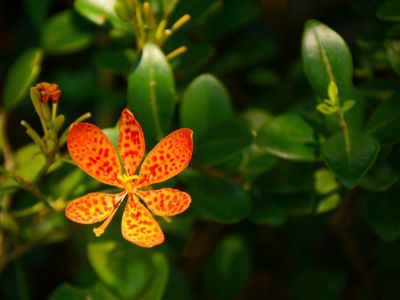The blackberry lily plant is also commonly named, not for the flowers, but for clusters of black fruit that grow after flowering, similar to a blackberry. Flowers of the blackberry lily plant are star-shaped, with six petals and are about 2 inches (5 cm.) across.
Blackberry Lily Plant
Blackberry lily plant, Belamcanda chinensis, is the most commonly grown plant of the species, the only one cultivated. Belamcanda blackberry lilies are of the Iris family, and were recently renamed ‘Iris domestica.’ Flowers of Belamcanda blackberry lilies last just a day, but during the bloom season there are always more to replace them. Blooms are followed by a dry cluster of black fruits in autumn. Foliage is similar to the iris, reaching 1 to 3 feet tall (0.5 to 1 m.). Blooms of growing blackberry lilies close at night in a twisting form. Ease of blackberry lily care and the beauty of the blooms make them a popular garden specimen for those who are familiar with them. Some U.S. gardeners don’t yet know about growing blackberry lilies, although Thomas Jefferson grew them at Monticello.
How to Grow a Blackberry Lily
Growing blackberry lilies begins with planting the bulbs (actually tubers). The blackberry lily plant can be planted at any time the ground is not frozen, in USDA hardiness zones 5 to 10a. When learning how to grow a blackberry lily, plant in a sunny to lightly shaded area with well draining soil. The yellow flowering type, Belamcanda flabellata, needs more shade and more water. Rich soil is not a requirement for this plant. Blackberry lily care is not complicated. Keep the soil moist. Try growing blackberry lilies with Asiatic and Oriental lilies, such as ‘Cancun’ and ‘Stargazer.’ Or plant them in mass for a sea of the delicate, mottled blooms.
